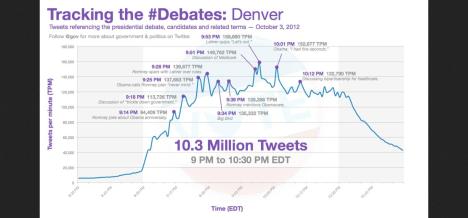The first presidential debate took place last night at the University of Denver between U.S. President Barack Obama and Republican Presidential Candidate Mitt Romney. It’s no secret that Twitter users “tweet in” for current events, and last night’s showing proved no different with more than 10 million tweets during the 90-minute debate, making it the most tweeted about event in American political history.
On its blog last night, Twitter released a minute-by-minute chart displaying high and low messaging points during key moments of the debate.
The night’s most tweeted about subjects included the performance of debate moderator John Lehrer and Big Bird. The Twitter Government account, @gov, tweeted that the phrase “Big Bird” had generated about 17,000 tweets per minute.
With every current event, there is always a PR lesson to be learned. The iconic home appliance brand KitchenAid discovered this quickly last night after an irresponsible tweet was sent from the company’s official account. The brand issued an apology soon after via Twitter and later to media.
With Twitter’s crisis communication moments and the constant stream of conversation, outlets like Politico seem to think that Twitter jumped the shark last night with the inability to follow comments due to the overwhelming volume of tweets sent. Of course some would disagree, as Twitter continues to prove that watching live and current events with the Twitter community has become a part of the culture for many.
Filed under: Uncategorized | Tagged: barack obama, big bird, brand, crisis communication, debate, john lehrer, kitchenaid, mashable, mitt romney, politico, pr, pradical, presidential debate, public relations, twitter, university of denver, USA Today | 2 Comments »



